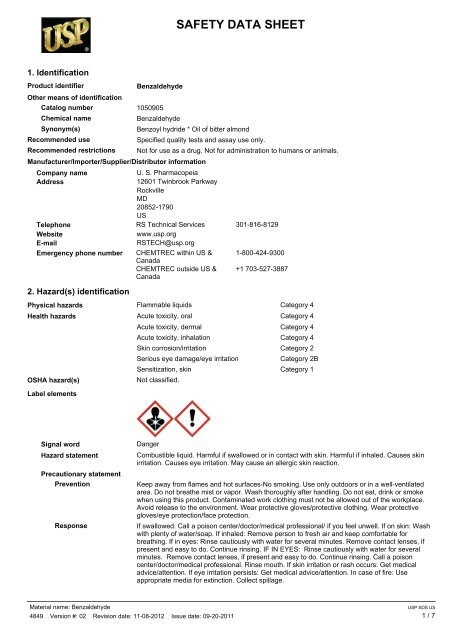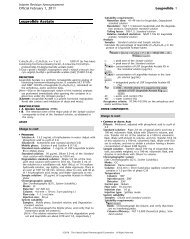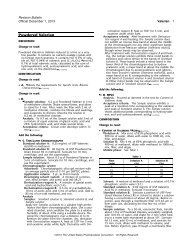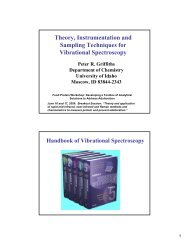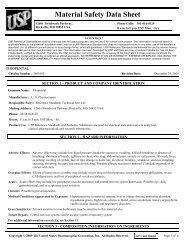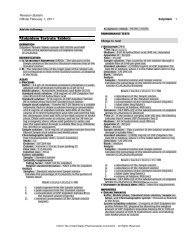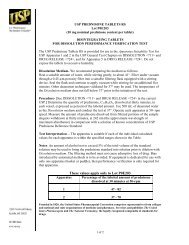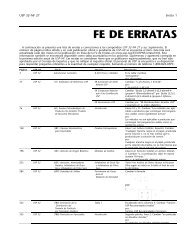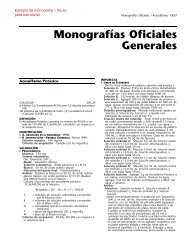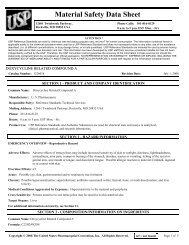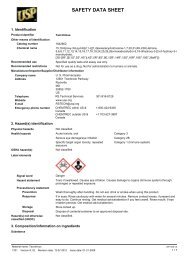SAFETY DATA SHEET - US Pharmacopeial Convention
SAFETY DATA SHEET - US Pharmacopeial Convention
SAFETY DATA SHEET - US Pharmacopeial Convention
Create successful ePaper yourself
Turn your PDF publications into a flip-book with our unique Google optimized e-Paper software.
1. Identification<br />
<strong>SAFETY</strong> <strong>DATA</strong> <strong>SHEET</strong><br />
Product identifier<br />
Other means of identification<br />
Benzaldehyde<br />
Catalog number 1050905<br />
Chemical name Benzaldehyde<br />
Synonym(s) Benzoyl hydride * Oil of bitter almond<br />
Recommended use Specified quality tests and assay use only.<br />
Recommended restrictions Not for use as a drug. Not for administration to humans or animals.<br />
Manufacturer/Importer/Supplier/Distributor information<br />
Company name<br />
U. S. Pharmacopeia<br />
Address<br />
12601 Twinbrook Parkway<br />
Rockville<br />
MD<br />
20852-1790<br />
<strong>US</strong><br />
Telephone RS Technical Services 301-816-8129<br />
Website<br />
www.usp.org<br />
E-mail RSTECH@usp.org<br />
Emergency phone number CHEMTREC within <strong>US</strong> &<br />
Canada<br />
CHEMTREC outside <strong>US</strong> &<br />
Canada<br />
2. Hazard(s) identification<br />
Physical hazards<br />
Health hazards<br />
OSHA hazard(s)<br />
Label elements<br />
Flammable liquids<br />
Acute toxicity, oral<br />
Acute toxicity, dermal<br />
Acute toxicity, inhalation<br />
Skin corrosion/irritation<br />
Serious eye damage/eye irritation<br />
Sensitization, skin<br />
Not classified.<br />
1-800-424-9300<br />
+1 703-527-3887<br />
Category 4<br />
Category 4<br />
Category 4<br />
Category 4<br />
Category 2<br />
Category 2B<br />
Category 1<br />
Signal word Danger<br />
Hazard statement Combustible liquid. Harmful if swallowed or in contact with skin. Harmful if inhaled. Causes skin<br />
irritation. Causes eye irritation. May cause an allergic skin reaction.<br />
Precautionary statement<br />
Prevention Keep away from flames and hot surfaces-No smoking. Use only outdoors or in a well-ventilated<br />
area. Do not breathe mist or vapor. Wash thoroughly after handling. Do not eat, drink or smoke<br />
when using this product. Contaminated work clothing must not be allowed out of the workplace.<br />
Avoid release to the environment. Wear protective gloves/protective clothing. Wear protective<br />
gloves/eye protection/face protection.<br />
Response If swallowed: Call a poison center/doctor/medical professional/ if you feel unwell. If on skin: Wash<br />
with plenty of water/soap. If inhaled: Remove person to fresh air and keep comfortable for<br />
breathing. If in eyes: Rinse cautiously with water for several minutes. Remove contact lenses, if<br />
present and easy to do. Continue rinsing. IF IN EYES: Rinse cautiously with water for several<br />
minutes. Remove contact lenses, if present and easy to do. Continue rinsing. Call a poison<br />
center/doctor/medical professional. Rinse mouth. If skin irritation or rash occurs: Get medical<br />
advice/attention. If eye irritation persists: Get medical advice/attention. In case of fire: Use<br />
appropriate media for extinction. Collect spillage.<br />
Material name: Benzaldehyde<br />
4849 Version #: 02 Revision date: 11-08-2012 Issue date: 09-20-2011<br />
<strong>US</strong>P SDS <strong>US</strong><br />
1 / 7
Storage Store in a well-ventilated place. Keep container tightly closed. Store in a well-ventilated place.<br />
Keep cool. Store locked up.<br />
Disposal Dispose of contents/container to an approved disposal site.<br />
Hazard(s) not otherwise<br />
classified (HNOC)<br />
Not classified.<br />
3. Composition/information on ingredients<br />
Substance<br />
Hazardous components<br />
Chemical name Common name and synonyms<br />
CAS number %<br />
Benzaldehyde Benzoyl hydride<br />
Oil of bitter almond<br />
100-52-7<br />
100<br />
4. First-aid measures<br />
Inhalation Causes irritation. Avoid inhalation. Remove to fresh air. Oxygen or artificial respiration if needed.<br />
Do not use mouth-to-mouth method if victim inhaled the substance. Call a POISON CENTER or<br />
doctor/physician if you feel unwell.<br />
Skin contact Causes irritation and possible allergic reaction. Avoid contact. Flush with copious quantities of<br />
soap and water. Get medical attention if irritation develops and persists.<br />
Eye contact Causes irritation. Flush with copious quantities of water for at least 15 minutes. Get medical<br />
attention if irritation develops and persists.<br />
Ingestion Rinse mouth thoroughly. If ingestion of a large amount does occur, call a poison control center<br />
immediately. Do not induce vomiting without advice from poison control center. If vomiting occurs,<br />
keep head low so that stomach content doesn't get into the lungs. Do not use mouth-to-mouth<br />
method if victim ingested the substance.<br />
Most important<br />
Irritant effects. May cause allergic skin reaction.<br />
symptoms/effects, acute and<br />
delayed<br />
Indication of immediate<br />
medical attention and special<br />
treatment needed<br />
Provide general supportive measures and treat symptomatically. Administer activated charcoal as<br />
an aqueous slurry, unless contraindicated. Perform gastric lavage if necessary. For respiratory<br />
distress, administer oxygen and assist ventilation. For bronchospasm, treat with inhaled beta2<br />
agonist and oral or parenteral corticosteroids. (Meditext)<br />
General information Remove from exposure. Remove contaminated clothing. For treatment advice, seek guidance<br />
from an occupational health physician or other licensed health-care provider familiar with<br />
workplace chemical exposures. In the United States, the national poison control center phone<br />
number is 1-800-222-1222. If person is not breathing, give artificial respiration. If breathing is<br />
difficult, give oxygen if available. Persons developing serious hypersensitivity (anaphylactic)<br />
reactions must receive immediate medical attention.<br />
5. Fire-fighting measures<br />
Suitable extinguishing media Water fog. Foam. Dry chemical powder. Carbon dioxide (CO2).<br />
Unsuitable extinguishing Do not use water jet as an extinguisher, as this will spread the fire.<br />
media<br />
Specific hazards arising from Not applicable.<br />
the chemical<br />
Special protective equipment Wear suitable protective equipment.<br />
and precautions for firefighters<br />
Fire-fighting<br />
equipment/instructions<br />
As with all fires, evacuate personnel to a safe area. Firefighters should use self-contained<br />
breathing equipment and protective clothing.<br />
Specific methods Cool containers exposed to flames with water until well after the fire is out.<br />
6. Accidental release measures<br />
Personal precautions,<br />
protective equipment and<br />
emergency procedures<br />
Methods and materials for<br />
containment and cleaning up<br />
7. Handling and storage<br />
ELIMINATE all ignition sources (no smoking, flares, sparks or flames in immediate area). Keep<br />
unnecessary personnel away. Do not touch damaged containers or spilled material unless<br />
wearing appropriate protective clothing. Avoid inhalation of vapors or mists. Wear appropriate<br />
personal protective equipment.<br />
ELIMINATE all ignition sources (no smoking, flares, sparks or flames in immediate area). Keep<br />
combustibles (wood, paper, oil, etc.) away from spilled material. Absorb spillage with<br />
non-combustible, absorbent material. Prevent entry into waterways, sewer, basements or<br />
confined areas. For waste disposal, see section 13 of the SDS. Wash spill site.<br />
Precautions for safe handling As a general rule, when handling <strong>US</strong>P Reference Standards avoid all contact and inhalation of<br />
dust, mists, and/or vapors associated with the material. Wash thoroughly after handling. Do not<br />
handle or store near an open flame, heat, or other sources of ignition.<br />
Material name: Benzaldehyde<br />
4849 Version #: 02 Revision date: 11-08-2012 Issue date: 09-20-2011<br />
2 / 7<br />
<strong>US</strong>P SDS <strong>US</strong>
Conditions for safe storage,<br />
including any incompatibilities<br />
8. Exposure controls/personal protection<br />
Occupational exposure limits<br />
<strong>US</strong>. Workplace Environmental Exposure Level (WEEL) Guides<br />
Store in tight container as defined in the <strong>US</strong>P-NF. This material should be handled and stored per<br />
label instructions to ensure product integrity.<br />
Material Type<br />
Value<br />
Benzaldehy de (CAS<br />
100-52-7)<br />
STEL 17.4 mg/m3<br />
4 ppm<br />
TWA 8.7 mg/m3<br />
2 ppm<br />
Biological limit values No biological exposure limits noted for the ingredient(s).<br />
Appropriate engineering Airborne exposure should be controlled primarily by engineering controls such as general dilution<br />
controls<br />
ventilation, local exhaust ventilation, or process enclosure. Local exhaust ventilation is generally<br />
preferred to general exhaust because it can control the contaminant at its source, preventing<br />
dispersion into the work area. An industrial hygiene survey involving air monitoring may be used<br />
to determine the effectiveness of engineering controls. Effectiveness of engineering controls<br />
intended for use with highly potent materials should be assessed by use of nontoxic surrogate<br />
materials.<br />
Local exhaust ventilation such as a laboratory fume hood or other vented enclosure is<br />
recommended, particularly for aerosol-generating procedures.<br />
Individual protection measures, such as personal protective equipment<br />
Eye/face protection<br />
Skin protection<br />
Safety glasses with sideshields are recommended. Face shields or goggles may be required if<br />
splash potential exists or if corrosive materials are present. Approved eye protection (e.g., bearing<br />
the ANSI Z87 or CSA stamp) is preferred. Maintain eyewash facilities in the work area.<br />
Hand protection Chemically compatible gloves. For handling solutions, ensure that the glove material is protective<br />
against the solvent being used. Use handling practices that minimize direct hand contact.<br />
Employees who are sensitive to natural rubber (latex) should use nitrile or other synthetic nonlatex<br />
gloves. Use of powdered latex gloves should be avoided due to the risk of latex allergy.<br />
Other For handling of laboratory scale quantities, a cloth lab coat is recommended. Where significant<br />
quantities are handled, work clothing may be necessary to prevent take-home contamination.<br />
Respiratory protection Where respirators are deemed necessary to reduce or control occupational exposures, use<br />
NIOSH-approved respiratory protection and have an effective respirator program in place<br />
(applicable U.S. regulation OSHA 29 CFR 1910.134).<br />
Thermal hazards Not available.<br />
General hygiene<br />
considerations<br />
Handle in accordance with good industrial hygiene and safety practice.<br />
9. Physical and chemical properties<br />
Appearance Colorless, strongly refractive liquid.<br />
Physical state Liquid.<br />
Form Liquid.<br />
Odor Bitter almond.<br />
Odor threshold 0.042 ppm<br />
pH 5.9<br />
Melting point/freezing point -14.8 °F (-26 °C)<br />
Initial boiling point and boiling<br />
range<br />
350.6 - 354.2 °F (177 - 179 °C)<br />
Flash point 147.20 °F (64.00 °C) Closed Cup<br />
Evaporation rate Not available.<br />
Flammability (solid, gas) Not applicable.<br />
Upper/lower flammability or explosive limits<br />
Flammability limit - lower<br />
(%)<br />
1.4 %<br />
Flammability limit - upper<br />
(%)<br />
8.5 %<br />
Explosive limit - lower (%) Not available.<br />
Explosive limit - upper (%) Not available.<br />
Vapor pressure 0.127 mm Hg at 25 ° C<br />
Material name: Benzaldehyde<br />
4849 Version #: 02 Revision date: 11-08-2012 Issue date: 09-20-2011<br />
<strong>US</strong>P SDS <strong>US</strong><br />
3 / 7
Vapor density 3.7 (air=1)<br />
Relative density Not available.<br />
Solubility in water Slightly soluble.<br />
Partition coefficient<br />
(n-octanol/water)<br />
1.5<br />
Auto-ignition temperature 374 °F (190 °C)<br />
Decomposition temperature Not available.<br />
Viscosity<br />
Other information<br />
Not available.<br />
Chemical family Aldehyde<br />
Molecular formula C7H6O<br />
Molecular weight 106.12<br />
Solubility (other) Miscible with alcohol, with ether, with chloroform, and with fixed and volatile oils; very soluble in<br />
acetone, in benzene, and in petroleum ether; soluble in liquid ammonia.<br />
Specific gravity 1.041 - 1.046 at 25°C<br />
10. Stability and reactivity<br />
Reactivity No reactivity hazards known.<br />
Chemical stability Risk of ignition.<br />
Possibility of hazardous Not available.<br />
reactions<br />
Conditions to avoid Heat. Flames. Sparks. Avoid temperatures exceeding the flash point. May form peroxides with air<br />
and light.<br />
Incompatible materials Strong oxidizing agents. Strong reducing agents. Strong bases. Strong acids. Aluminum.<br />
Ammonia. Amines. Iron. Phenol. Performic acid.<br />
Hazardous decomposition Benzoic acid. Irritating and/or toxic fumes or gases. Emits toxic fumes under fire conditions.<br />
products<br />
11. Toxicological information<br />
Information on likely routes of exposure<br />
Ingestion Harmful if swallowed.<br />
Inhalation Harmful if inhaled.<br />
Skin contact Harmful in contact with skin. May cause an allergic skin reaction.<br />
Eye contact Causes eye irritation.<br />
Symptoms related to the Irritant effects. Skin inflammation. Defatting of the skin. Cough. Shortness of breath. Dizziness.<br />
physical, chemical, and Headache. Nausea. Vomiting. Abdominal pain. Sore throat. Convulsions. Decrease in motor<br />
toxicological characteristics functions.<br />
Delayed and immediate effects<br />
of exposure<br />
Respiratory failure.<br />
Acute toxicity Harmful if inhaled. Harmful if swallowed. Harmful in contact with skin.<br />
Product<br />
Benzaldehyde (CAS 100-52-7)<br />
Species<br />
Test Results<br />
Acute<br />
Dermal<br />
LD50 Guinea pig<br />
> 2000 mg/kg<br />
Rabbit > 1250 mg/kg<br />
Inhalation<br />
LC50 Rat<br />
> 3 mg/l<br />
Oral<br />
LD50 Guinea pig<br />
1000 mg/kg<br />
Rat 1300 mg/kg<br />
Skin corrosion/irritation Causes skin irritation.<br />
Serious eye damage/eye<br />
irritation<br />
Causes eye irritation.<br />
Material name: Benzaldehyde<br />
4849 Version #: 02 Revision date: 11-08-2012 Issue date: 09-20-2011<br />
<strong>US</strong>P SDS <strong>US</strong><br />
4 / 7
Local effects<br />
Irritation test<br />
Result: Irritant.<br />
Species: Rabbit<br />
Organ: Eye<br />
Severity: Mild.<br />
irritation test (500 mg)<br />
Result: Irritant.<br />
Species: Rabbit<br />
Organ: Skin<br />
Test Duration: 24 hours<br />
Severity: Moderate.<br />
Respiratory sensitization Due to lack of data the classification is not possible.<br />
Skin sensitization May cause an allergic skin reaction.<br />
Germ cell mutagenicity Based on available data, the classification criteria are not met.<br />
Mutagenicity<br />
1 mmol/L Sister chromatid exchange in human lympocyte<br />
Result: Positive.<br />
400 mg/l Mutagenicity test in mouse lympocyte<br />
Result: Positive.<br />
Chromosomal aberration test in hamster<br />
Result: Negative.<br />
N crassa-reversion assay<br />
Result: Positive.<br />
S. typhimurium Ames assay<br />
Result: Negative.<br />
Carcinogenicity This product is not considered to be a carcinogen by IARC, ACGIH, NTP, or OSHA. Based on<br />
available data, the classification criteria are not met.<br />
154 g/kg Carcinogenicity test<br />
Result: Positive.<br />
Species: Mouse<br />
Test Duration: 2 years<br />
400 mg/kg/day Carcinogenicity test<br />
Result: Negative.<br />
Species: Rat<br />
Test Duration: 2 years<br />
Reproductive toxicity Due to lack of data the classification is not possible.<br />
Specific target organ toxicity - Due to lack of data the classification is not possible.<br />
single exposure<br />
Specific target organ toxicity - Due to lack of data the classification is not possible.<br />
repeated exposure<br />
Aspiration hazard Due to lack of data the classification is not possible.<br />
12. Ecological information<br />
Ecotoxicity<br />
Product Species<br />
Test Results<br />
Benzaldehyde (CAS 100-52-7)<br />
Aquatic<br />
Fish LC50<br />
Bluegill (Lepomis macrochirus) 0.8 - 1.44 mg/l, 96 hours<br />
Persistence and degradability No data is available on the degradability of this product.<br />
Bioaccumulative potential Not available.<br />
Mobility in soil Not available.<br />
Other adverse effects Not available.<br />
13. Disposal considerations<br />
Disposal instructions This product, in its present state, when discarded or disposed of, is not a hazardous waste<br />
according to Federal regulations (40 CFR 261.4 (b)(4)). Under RCRA, it is the responsibility of<br />
the user of the product to determine, at the time of disposal, whether the product meets RCRA<br />
criteria for hazardous waste. Dispose in accordance with all applicable regulations.<br />
Local disposal regulations Not available.<br />
Hazardous waste code Not regulated.<br />
Waste from residues / unused<br />
products<br />
Material name: Benzaldehyde<br />
4849 Version #: 02 Revision date: 11-08-2012 Issue date: 09-20-2011<br />
Empty containers or liners may retain some product residues. This material and its container must<br />
be disposed of in a safe manner (see: Disposal instructions).<br />
<strong>US</strong>P SDS <strong>US</strong><br />
5 / 7
Contaminated packaging Empty containers should be taken to an approved waste handling site for recycling or disposal.<br />
Since emptied containers may retain product residue, follow label warnings even after container is<br />
emptied.<br />
14. Transport information<br />
DOT<br />
UN number<br />
UN proper shipping name<br />
Transport hazard class(es)<br />
Subsidiary class(es)<br />
Packing group<br />
IATA<br />
UN number<br />
UN proper shipping name<br />
Transport hazard class(es)<br />
Subsidiary class(es)<br />
Packaging group<br />
Environmental hazards<br />
Transport in bulk according to<br />
Annex II of MARPOL 73/78 and<br />
the IBC Code<br />
DOT; IATA<br />
15. Regulatory information<br />
UN1990<br />
Benzaldehyde<br />
9<br />
Not available.<br />
III<br />
UN1990<br />
Benzaldehyde<br />
9<br />
-<br />
III<br />
No<br />
No information available.<br />
<strong>US</strong> federal regulations All components are on the U.S. EPA TSCA Inventory List.<br />
CERCLA/SARA Hazardous Substances - Not applicable.<br />
Superfund Amendments and Reauthorization Act of 1986 (SARA)<br />
Hazard categories Immediate Hazard - Yes<br />
Delayed Hazard - Yes<br />
Fire Hazard - Yes<br />
Pressure Hazard - No<br />
Reactivity Hazard - No<br />
SARA 302 Extremely<br />
hazardous substance<br />
No<br />
SARA 311/312 Hazardous<br />
chemical<br />
Other federal regulations<br />
No<br />
Safe Drinking Water Act<br />
(SDWA)<br />
Not regulated.<br />
Food and Drug<br />
Administration (FDA)<br />
Controlled substance<br />
<strong>US</strong> state regulations<br />
International Inventories<br />
California Safe Drinking Water and Toxic Enforcement Act of 1986 (Proposition 65): This material<br />
is not known to contain any chemicals currently listed as carcinogens or reproductive toxins.<br />
Country(s) or region Inventory name On inventory (yes/no)*<br />
Australia Australian Inventory of Chemical Substances (AICS)<br />
Yes<br />
Canada Domestic Substances List (DSL)<br />
Yes<br />
Canada Non-Domestic Substances List (NDSL)<br />
No<br />
China Inventory of Existing Chemical Substances in China (IECSC)<br />
Yes<br />
Europe European Inventory of Existing Commercial Chemical<br />
Substances (EINECS)<br />
Yes<br />
Europe European List of Notified Chemical Substances (ELINCS)<br />
No<br />
Material name: Benzaldehyde<br />
4849 Version #: 02 Revision date: 11-08-2012 Issue date: 09-20-2011<br />
<strong>US</strong>P SDS <strong>US</strong><br />
6 / 7
Country(s) or region Inventory name On inventory (yes/no)*<br />
Japan Inventory of Existing and New Chemical Substances (ENCS)<br />
Yes<br />
Korea Existing Chemicals List (ECL)<br />
Yes<br />
New Zealand New Zealand Inventory<br />
Yes<br />
Philippines Philippine Inventory of Chemicals and Chemical Substances<br />
(PICCS)<br />
United States & Puerto Rico Toxic Substances Control Act (TSCA) Inventory<br />
*A "Yes" indicates that all components of this product comply with the inventory requirements administered by the governing country(s)<br />
16. Other information, including date of preparation or last revision<br />
Issue date 09-20-2011<br />
Revision date 11-08-2012<br />
Version # 02<br />
Further information Not available.<br />
Disclaimer <strong>US</strong>P Reference Standards are sold for chemical test and assay purposes only, and NOT for<br />
human consumption. The information contained herein is applicable solely to the chemical<br />
substance when used as a <strong>US</strong>P Reference Standard and does not necessarily relate to any other<br />
use of the substance described, (i.e. at different concentrations, in drug dosage forms, or in bulk<br />
quantities). <strong>US</strong>P Reference Standards are intended for use by persons having technical skill and<br />
at their own discretion and risk. This information has been developed by <strong>US</strong>P staff from sources<br />
considered reliable but has not been independently verified by the <strong>US</strong>P. Therefore, the <strong>US</strong>P<br />
<strong>Convention</strong> cannot guarantee the accuracy of the information in these sources nor should the<br />
statements contained herein be considered an official expression. NO REPRESENTATION OR<br />
WARRANTY, EXPRESS OR IMPLIED, INCLUDING THE WARRANTIES OF MERCHANTABILITY<br />
AND FITNESS FOR A PARTICULAR PURPOSE is made with respect to the information<br />
contained herein.<br />
Revision Information This document has undergone significant changes and should be reviewed in its entirety.<br />
Material name: Benzaldehyde<br />
4849 Version #: 02 Revision date: 11-08-2012 Issue date: 09-20-2011<br />
Yes<br />
Yes<br />
<strong>US</strong>P SDS <strong>US</strong><br />
7 / 7


